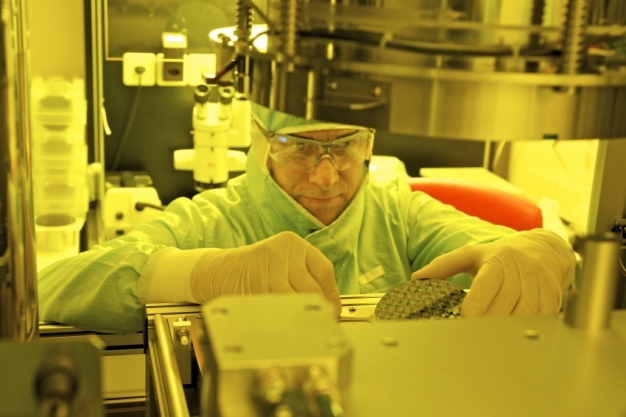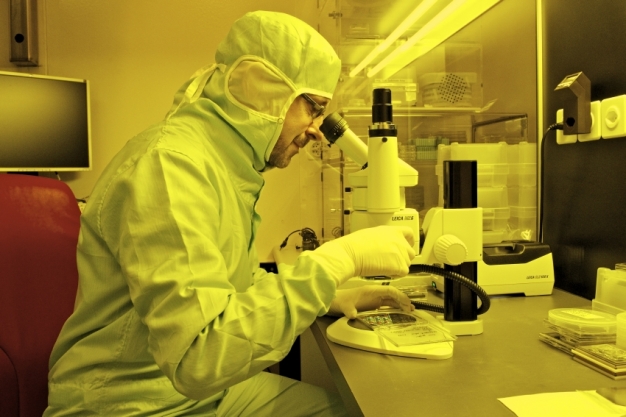Alexandra von Ascheraden
The cleanest place at the Paul Scherrer Institute
The PSI cleanrooms boast an almost particle-free environment
Highly sensitive processes take place in the cleanrooms of the Paul Scherrer Institute (PSI) as a single dust particle in the wrong place could have disastrous consequences. Here is a glimpse behind the scenes in rooms that are so clean even pencils are prohibited.
Anyone who attends the cleanroom course conducted by Martin Bednarzik, head of the technology development group at the PSI Laboratory for Micro and Nanotechnology, and his colleague Anja Weber is bound to regard his or her surroundings differently afterwards. The lab operates three cleanrooms: two located in the PSI Ost campus of the institute and a smaller one directly at Swiss Light Source (SLS), one of the PSI’s large-scale research facilities on the other side of the River Aare. «Just as the PSI has been operating mechanical workshops to produce the components necessary for the large facilities since the year dot, a state-of-the-art research centre also needs cleanrooms with micro-fabrication processes,» explains Helmut Schift, head of the polymer nanotechnology group.
Before you are allowed to work in a cleanroom at the PSI, however, you attend a two-day training with Martin Bednarzik, where he explains that a person who is not moving gives off 100,000 particles a minute, the majority of which are tiny flakes of skin. When doing sport, however, it can be as many as 10,000,000 particles. These numbers essentially refer to all particles that are so small they are able to float in the air.
Bednarzik does not mention this to create any unease, but rather to highlight why the cleanrooms he is responsible for are so special. A cleanroom is defined by the number of particles floating in the air inside it. In a conventional room, this can be as many as a million particles per cubic foot (one cubic foot is equivalent to around twenty-eight litres; in other words, the amount of air in the cooking chamber of a microwave unit). At certain points in the cleanroom, however, it may even be only ten particles per cubic foot – even if people are moving around inside, continuously giving off particles.
Fuzz-free overall
Consequently, the cleanroom course also teaches you to don the mandatory special overalls complete with head and foot covers. In the cleanroom, you are not even allowed to write on normal paper: special lint-free cleanroom paper is regulation, and rubbers and pencils are also prohibited. The strict rules are necessary because micro and nanoproduction needs to take place in an extremely clean environment.
Complex structures are carved out there layer by layer from silicon wafers (see box). The wafer is coated with a thin light-sensitive film, a special partially transparent stencil is placed on top and the whole stack is exposed – much like in a classical photo lab, where you expose the negative of a black-and-white photograph over photographic paper to transfer the image. The film is then developed and the wafer etched. In doing so, the patterned film structure is transferred deep into the material. The remaining layer of film is removed and the process repeated with further stencils on the same wafer until the desired structure is finished.
This is how nanostructured «lenses» for x-rays used at the SLS or components for detectors that identify newly created particles at CERN are produced.
Dust like boulders
The highly complex structures such components require are so fine that a single speck of dust falling onto the wafer during the production process would be catastrophic. Thomas Neiger, one of the cleanrooms’ «infrastructure technicians», explains why the air in the room has to be so extremely clean: «Every tiny dirt particle would eat into the wafer during processing. A speck of dust is a boulder compared to the component that is being produced. Statistically speaking, however, the risk of a foreign body getting onto the wafer in our cleanrooms is virtually nil.»
In order to provide the almost particle-free environment necessary for production, the technicians go to great lengths to filter and prepare the air. Giant pieces of equipment move throughout the entire building. The purified, temperature-controlled, dehumidified air is conducted into the room over the workstations vertically from above and without any turbulence and back out again via the perforated worktables. As a result, the few remaining floating particles are unable to settle on the work surfaces. The air in the room is replaced completely every two minutes.
Due to the elaborate technology, every cleanroom basically has to be five to six metres high, the majority of which is taken up by the air treatment machinery. The PSI cleanrooms, however, are some way short of this height as they had to be installed in existing buildings with considerably lower ceilings. Consequently, the technicians had a trick up their sleeves: twice a week, a special floor is treated with a sticky substance that prevents the few remaining particles from being stirred up.
All the equipment in the cleanroom runs continuously for twenty-four hours a day – the only way a constant temperature be guaranteed, which is vital for the complicated production processes. The networks are battery-supported as some machines cannot tolerate a power failure. «Sometimes, we even have to provide a separate voltage frequency as the manufacturers of machines we obtain from the USA have little interest in our Swiss frequencies,» reports Neiger.
Like space travel
«Needless to say, we regularly have to explain why what we do is so expensive. Generally speaking, you can say that we have to work just as reliably as in space travel,» says Helmut Schift. The bill is straightforward: operating one square metre of cleanroom costs at least a thousand Swiss francs a year. «This includes everything, from the special gloves to the electricity costs for the air-conditioning unit,» Schift explains. «The maintenance and incidental costs are high. In return, the production results are always flawless and repeatable at any time. And that’s ultimately what counts.»
Wafers
The wafers used at the PSI are round disks that are about 0.5 mm thick and made of silicon or another semiconductor material. In the semiconductor industry, they form the basis for integrated circuits such as computer chips. At the PSI, however, the wafers are used as a perfectly pure material for the production of x-ray lenses, detectors or «imprint stamps».
Paul Scherrer Institut
5232 Villigen PSI
Switzerland










